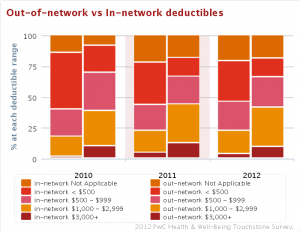Pricewaterhousecoopers (PwC) released a study last month that projects another year of low medical cost trends. They project an increase of 7.5 percent, the same as in 2012.
Ccertainly, a portion of thanks goes to the economy, which has constrained utilization. PwC also identifies four factors that will deflate 2013 medical cost trend:
- Medical supply and equipment costs come down under pressure, competition and consolidation.
- Employers and others turn to lower-cost options for delivering primary care services, such as retail and worksite clinics, telemedicine and mobile health tools.
- Price transparency empowers individuals to choose and emboldens employers to exact price justification.
- Brand-name drugs lose patent exclusivity and the related stranglehold on high-cost prescriptions.
Cost-shifting to employees a factor
The Pricewaterhousecoopers study also attributes cost containment to employers cost-shifting strategies to employees, whether through high-deductible health plans or increased copays. But, PwC notes a troubling complement to this cost-shifting that’s been discussed by others:
This shift is changing behavior and ultimately utilization; some employees are learning to shop around for needed care, while others forgo elective procedures or possibly delay care. A recent HRI survey found that 46 percent of consumers had delayed care at least once in the previous year, and 10 percent had delayed care ?ve or more times.”
 Forgoing preventive and routine care is in nobody’s best interest, so PwC offers several items for employers to consider:
Forgoing preventive and routine care is in nobody’s best interest, so PwC offers several items for employers to consider:
- Collect data and review the effectiveness of the company’s efforts;
- Communicate, educate and facilitate wellness;
- Promote value by offering low-cost options, such as onsite clinics and telemedicine;
- Use value-based approaches to benefits to drive, reward and sustain the desired behaviors.
To review Pricewaterhousecooper’s’ data, register to read the full report here.
This was originally published on Fran Melmed’s free-range communication blog.
